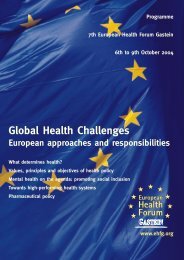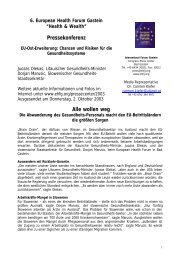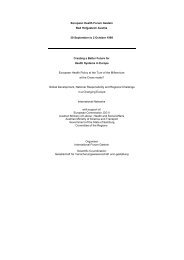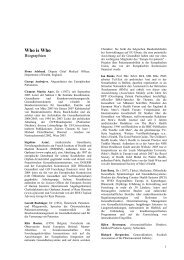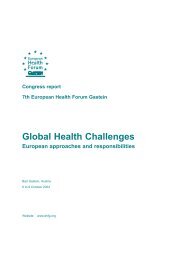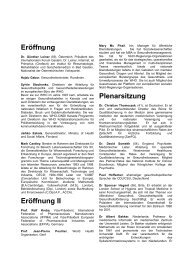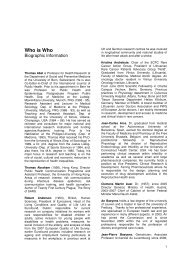Congress report - European Health Forum Gastein
Congress report - European Health Forum Gastein
Congress report - European Health Forum Gastein
You also want an ePaper? Increase the reach of your titles
YUMPU automatically turns print PDFs into web optimized ePapers that Google loves.
Plenary Session I + II<br />
improvements in the environment (e.g. the introduction of sanitation measures), living<br />
conditions (e.g. better housing and nutrition), and other factors related to social and<br />
economic development (e.g. increased family income). Medical breakthroughs, such as the<br />
availability of vaccination and immunization, came after the Second World War, by which<br />
time the major drop in mortality rates had already occurred (35).<br />
In developed countries, the receding pandemics of infection during the 18th and 19th centuries<br />
were attributable more as a response to social, economic and environmental changes than to<br />
medical breakthroughs (34). The latter were few and came too gradually and too late to be<br />
responsible for the changes in health and disease patterns. The policy implications of all this<br />
are still largely overlooked. There is no doubt that the explanation for this reduction in<br />
mortality is strongly linked to improvements in living and working conditions brought about<br />
by social and economic development (14,33,34,35,41,43,79).<br />
To argue that falls in death rates and the decline of pandemics in the last two centuries have<br />
been primarily related to changes in the environment, in the nutritional status of the<br />
population, in the supply of clean water, in the effective disposal of excreta, rather than to a<br />
specific medical intervention is not to downplay the role of the medical profession in<br />
achieving these successes. In many cases it was physicians who saw the relationships<br />
between nutrition, water supply, sanitation, poverty and illness and forced the authorities to<br />
take action (46,47). <strong>Health</strong> professions have played, and continue to have, an important role<br />
to play in changing disease patterns. What is important to recognize is that the actions to<br />
control or eradicate diseases are often social, economic or environmental interventions.<br />
2.2 Evidence from the Present<br />
Turning to the present, a number of recent studies focus specifically on the issue of social<br />
and economic development as key categories of health determinants<br />
(8,9,13,31,35,48,53,54,56). Several studies point out that the early signs of deterioration in<br />
the health status of populations are, in general, determined by changes in their social,<br />
economic and environmental conditions (see for example: 23,48,50,56,57,58).<br />
At national level, there is a demonstrable relationship between economic performance,<br />
income distribution, and health status, which has significant implications for social and<br />
economic policy-making. The higher a country’s average income per capita and the more<br />
equal its income distribution, the greater the likelihood of longer and healthier lives for its<br />
population (61,64). Maternal and child health patterns often reflect general economic trends.<br />
For example, child and infant mortality rates have been found to be sensitive to economic<br />
hardship. Studies in developing countries have shown that a 10% increase in income per<br />
capita corresponds to a 3.5% fall in child mortality rates (57). According to the World Bank,<br />
this estimate reflects the total impact of income on health. It includes efforts working directly<br />
through income (e.g. food consumption), as well as indirectly through factors that are<br />
themselves mainly determined by income (e.g. access to safe water and sanitation,<br />
availability of health care, etc.).<br />
There is now overwhelming evidence that much of contemporary illnesses and death (and<br />
thus the potential for the promotion of the health of the population) are rooted in the<br />
prevailing type of economic development and linked to social factors (8,9,11,12,13,30,48,53).<br />
In general, if economic development goes hand in hand with decreasing social inequalities, is<br />
environmentally friendly and strengthens social capital, it will have positive impact on a wide<br />
range of social and health indicators. In both developed and developing countries the<br />
number of people in poverty is an especially important reason for differences (inequalities) in<br />
health. In every society the income and status of women exact a powerful influence on<br />
population health. Especially in the poorest countries, policies that accelerate family income<br />
International <strong>Forum</strong> <strong>Gastein</strong>, Tauernplatz 1, A-5630 Bad Hofgastein<br />
Tel.: +43 (6432) 7110-70, Fax: Ext. 71, e-mail: info@ehfg.org, website: www.ehfg.org<br />
51





